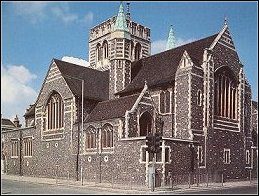 Holy Rood occupies an almost square site bounded on three sides by roads Market Street, Percy Road and Exchange Road, from where in typical Bentley fashion the walls rise sheer and uncluttered from the pavement. The materials used are in the ancient local tradition of knapped flint facing, stone dressing, which provides a durable and very attractive surface. Again in the local tradition the building is roofed in red tiles and lead.
Holy Rood occupies an almost square site bounded on three sides by roads Market Street, Percy Road and Exchange Road, from where in typical Bentley fashion the walls rise sheer and uncluttered from the pavement. The materials used are in the ancient local tradition of knapped flint facing, stone dressing, which provides a durable and very attractive surface. Again in the local tradition the building is roofed in red tiles and lead.
Holy Rood Church, view from Exchange Road
On the north-west corner is placed the quite splendid square flint tower with its lavish stone patterning, traceried and pierced crenellation and shapely leaden flèche, or ‘Hertfordshire Spike’. Again in the local tradition the building is roofed in red tiles and lead. On the north-west corner is placed the quite splendid square flint tower with its lavish stone patterning, traceried and pierced crenellation and shapely leaden flèche, or ‘Hertfordshire Spike’.
The many gables, the varied levels, the different window sizes and heights, the contrast between the light Bath stone and the dark flint, the verticals of the buttresses and octagonal Sanctus and Angelus turrets the clean horizontals of the roof, offer a lively but harmonious general aspect and one that is highly sensitive to its environment. Holy Rood compliments nearby neighbour, the 14th century church of St. Mary, and sits warmly comfortably among the houses and shops which surround it. The roof line the nave, chancel and transepts indicate a cruciform shape appropriate to its dedication, although this is not so obvious inside except, again, at roof level where the barrel vaulting forms a cross.